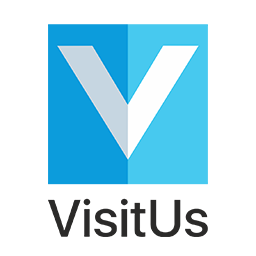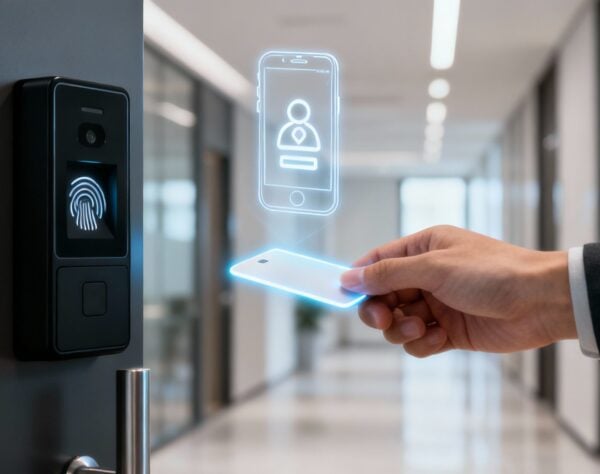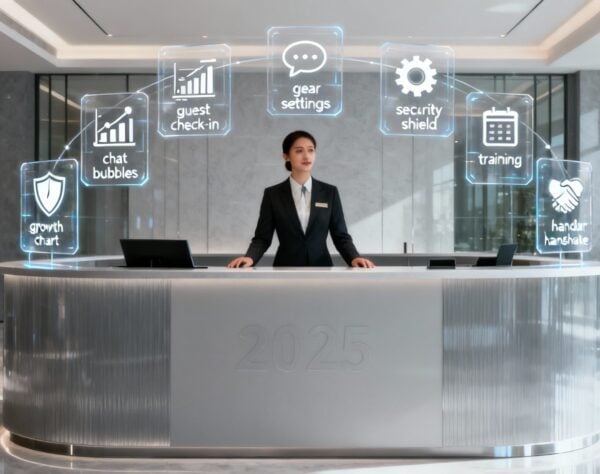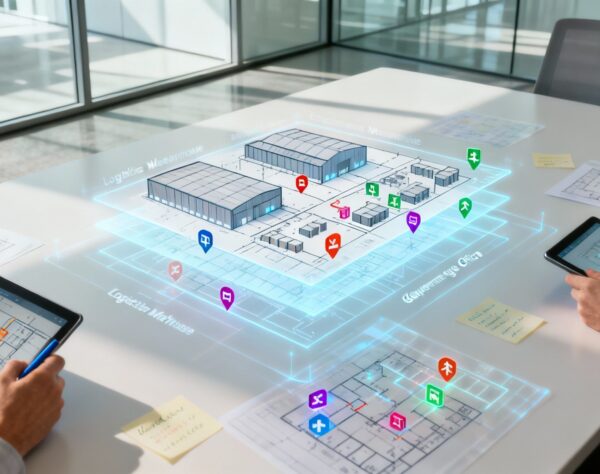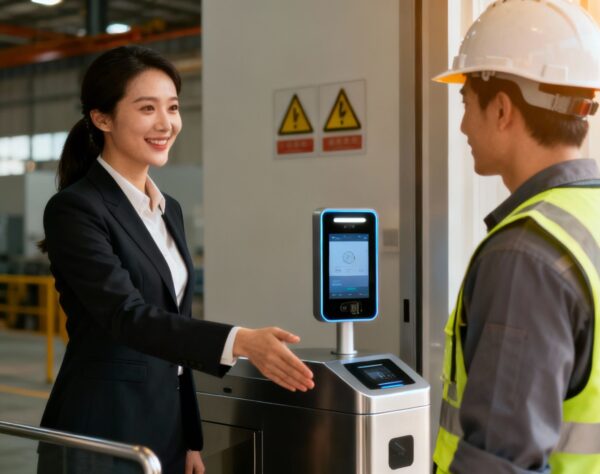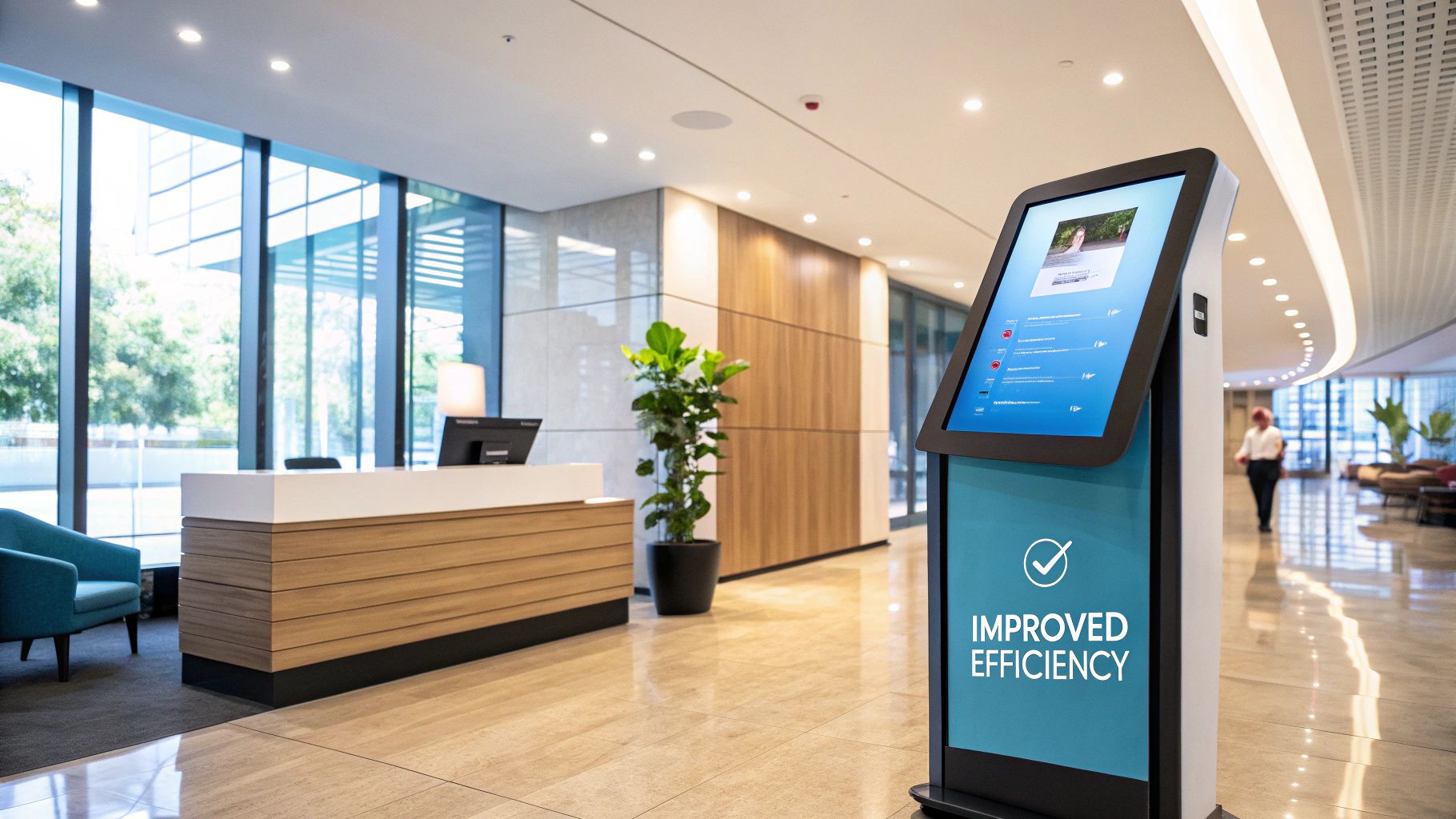
The Ultimate Guide to a Visitor Management System for Offices
A modern visitor management system for offices does more than replace an outdated paper logbook. It transforms your front desk into a smart hub that enhances security, boosts efficiency, and creates a stellar guest experience. It's a strategic tool for protecting your data, keeping employees safe, and making an unforgettable first impression.
Moving Beyond the Paper Logbook
The era of the spiral-bound notebook at the reception desk is over. While simple, that manual method created significant risks, from illegible handwriting and exposed private information to a complete inability to screen who was entering your premises.
In today's security-conscious world, a paper sign-in sheet offers a false sense of safety. It fails to provide tangible benefits like real-time security alerts, instant host notifications upon a guest's arrival, or valuable insights into your office's visitor traffic.
A New Standard for Office Receptions
Adopting a digital visitor management system for offices is a fundamental upgrade to your building's operational intelligence. These systems serve as a digital gatekeeper, ensuring every individual is properly identified, expected, and accounted for, quickly becoming the new industry standard.
This shift is driven by a heightened awareness of security vulnerabilities. The proof is in the numbers: the global market for visitor management systems is projected to surge from USD 1.8 billion in 2025 to USD 6.9 billion by 2035. This explosive growth is fueled by critical concerns over physical security and data protection. You can explore more about this market expansion to understand the drivers.
This chart highlights the clear advantages of a digital system over manual methods.
The data shows that automation dramatically accelerates the check-in process while significantly strengthening overall office security.
The transition from a flimsy paper log to a robust digital system delivers clear, measurable benefits. The difference is stark, as this comparison illustrates.
Paper Log vs. Digital VMS: A Quick Comparison
| Benefit Area | Paper Logbook | Digital VMS |
|---|---|---|
| Security | Minimal. No screening, easy to fake. | High. Screens against watchlists, photo capture. |
| Efficiency | Slow. Manual entry, receptionist interruptions. | Fast. Self-service check-in, instant host alerts. |
| Visitor Experience | Impersonal and dated. | Professional and modern. |
| Data Privacy | Poor. Personal info is visible to everyone. | Excellent. Data is encrypted and stored securely. |
| Compliance | Difficult to track and audit. | Simplified. Digital records for easy auditing. |
| Analytics | None. | Rich data on visitor traffic and patterns. |
For any modern office that values security and professionalism, upgrading isn't just a choice—it's a strategic necessity.
More Than Just a Digital Logbook
A modern VMS is a central command center delivering real benefits across your entire organization.
A well-implemented visitor management system is the first line of defense in your security strategy and a critical touchpoint for your brand identity. It turns the simple act of arrival into a secure, professional, and welcoming experience.
By automating routine tasks and capturing valuable data, these platforms provide advantages felt far beyond the lobby:
- Strengthened Security: Benefit from proactive threat prevention by screening visitors against internal watchlists, ensuring only authorized individuals gain entry.
- Improved Efficiency: Reclaim valuable time for your administrative staff. With automated check-ins and notifications, they can focus on high-impact tasks, as studies show automation can boost productivity by up to 30%.
- Enhanced Visitor Experience: Make an outstanding first impression with a seamless, professional welcome. Pre-registration and QR code check-ins create a smooth arrival that reflects a modern, organized brand.
The Strategic Benefits of a Modern VMS
A modern visitor management system is a strategic investment that delivers tangible returns in security, operational efficiency, and brand perception. It's a cornerstone for achieving your broader business objectives.
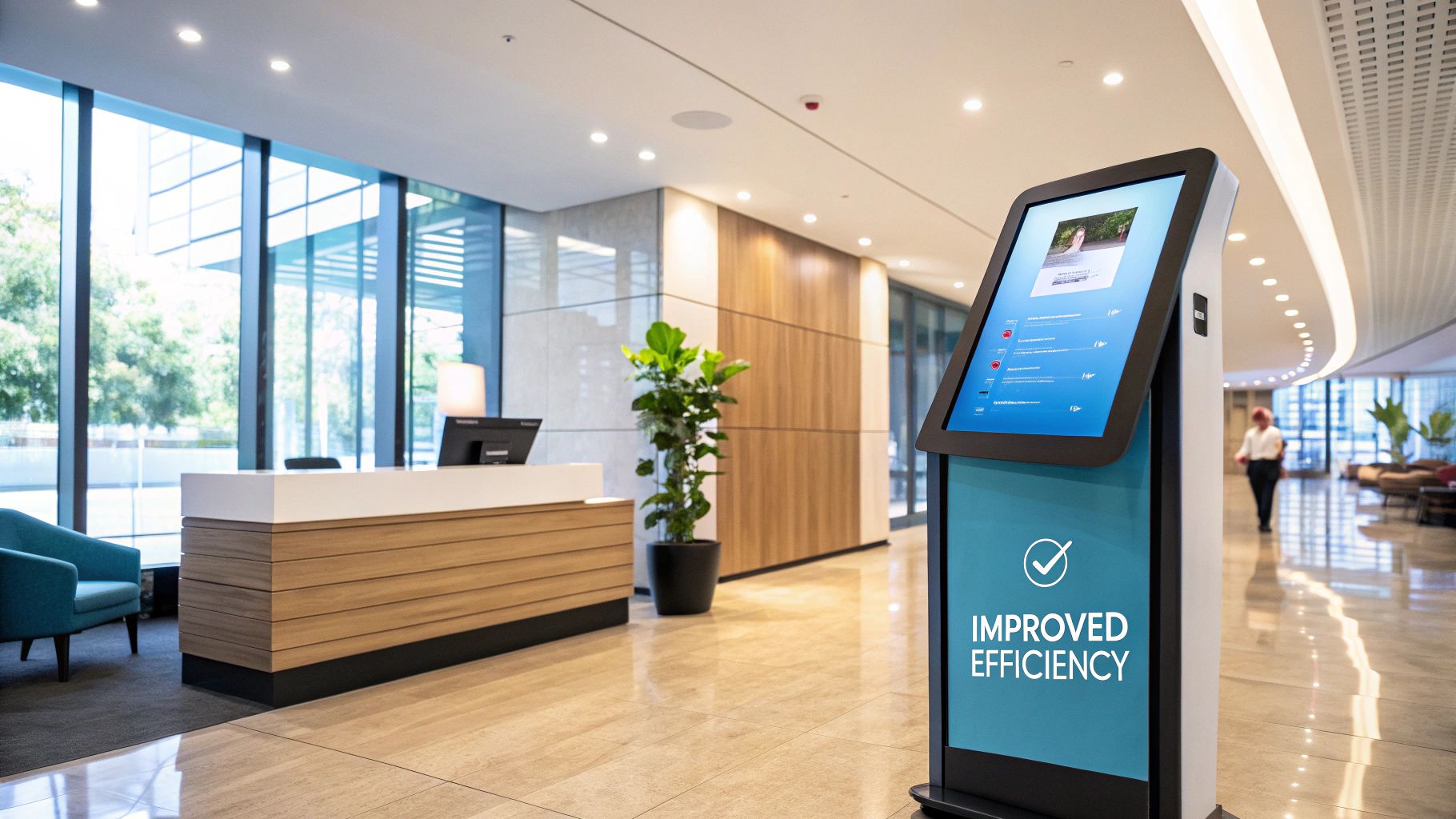
The advantages fall into three key categories: proactive security, streamlined operations, and an elevated visitor experience. Each benefit addresses a critical challenge for today's offices, transforming potential weaknesses into strengths. You can clearly measure the return on investment from digital transformation as you move from outdated manual methods.
Creating a Proactively Secure Environment
The most significant benefit of a modern visitor management system for offices is its ability to shift security from a reactive to a proactive stance. A paper log only provides information after an incident. A VMS helps prevent incidents by offering a live, verified overview of everyone in your building.
This is critical, as a recent study found that 75% of businesses view physical security breaches as a major operational threat. A VMS directly mitigates this risk by creating automated layers of defense. For instance, watchlist screening automatically checks visitors against "do not admit" lists, flagging a potential risk before they get past reception—a benefit impossible to achieve with a logbook.
A modern VMS turns your reception area from a passive sign-in desk into an active security checkpoint. It gives you the confidence of knowing, right now, that every single person on-site is supposed to be there.
Key security benefits include:
- Real-Time Host Notifications: Immediately upon check-in, hosts are notified via email, SMS, or Slack. This simple automation eliminates the risk of unescorted guests and ensures every visitor is accounted for.
- Digital Audit Trails: Benefit from a complete, unalterable digital record of every visit, including photos, timestamps, and signed NDAs. This data is invaluable for compliance audits and security investigations.
- Emergency Evacuation Lists: In an emergency, you gain the ability to instantly generate an accurate, up-to-the-minute list of all on-site visitors, providing critical information to first responders to ensure everyone's safety.
Enhancing Your Operational Efficiency
Beyond security, a visitor management system is an efficiency powerhouse that saves time and money. It automates repetitive administrative tasks, allowing your front-desk team to focus on value-added activities.
Research suggests office workers can lose up to 25% of their day to interruptions and inefficient processes. A VMS eliminates the time wasted deciphering messy handwriting, manually entering data, or tracking down hosts. This automation eradicates lobby bottlenecks, especially during peak hours. Self-service kiosks and pre-registration allow visitors to sign in and receive their badge in seconds. For a deeper understanding of the process, you can read our guide on what a visitor management system is.
Elevating the Modern Visitor Experience
The visitor experience begins at your front door. A clunky, paper-based process can create a poor first impression, making your company appear outdated. A smooth, professional welcome demonstrates your commitment to quality and innovation.
A modern VMS makes this polished arrival effortless.
1. Pre-Registration Convenience: Hosts can pre-register guests, who then receive a branded email with a QR code, directions, and Wi-Fi details. This transforms their on-site check-in into a process that takes mere seconds.
2. Streamlined On-Site Check-In: For walk-ins, an intuitive tablet guides them through a quick sign-in. They can take their photo and digitally sign documents like NDAs directly on the screen, creating a seamless experience.
3. A Professional Welcome: The entire process is branded, from the welcome screen to the custom-printed visitor badge. This reinforces your corporate identity and sends a clear message that you are an organized, modern business—a benefit a spiral-bound logbook can never provide.
How a VMS Strengthens Security and Compliance
A modern visitor management system for offices is your front-line defense in a world of complex security and data privacy regulations. With rules like GDPR and CCPA, proper handling of visitor information is a legal mandate, not just good practice.
A paper logbook is a compliance nightmare, leaving personal data exposed for anyone to see. A VMS transforms this vulnerability into a strength by securing all visitor data in a digital fortress. This demonstrates a serious commitment to data protection, building trust with clients, partners, and your own team.
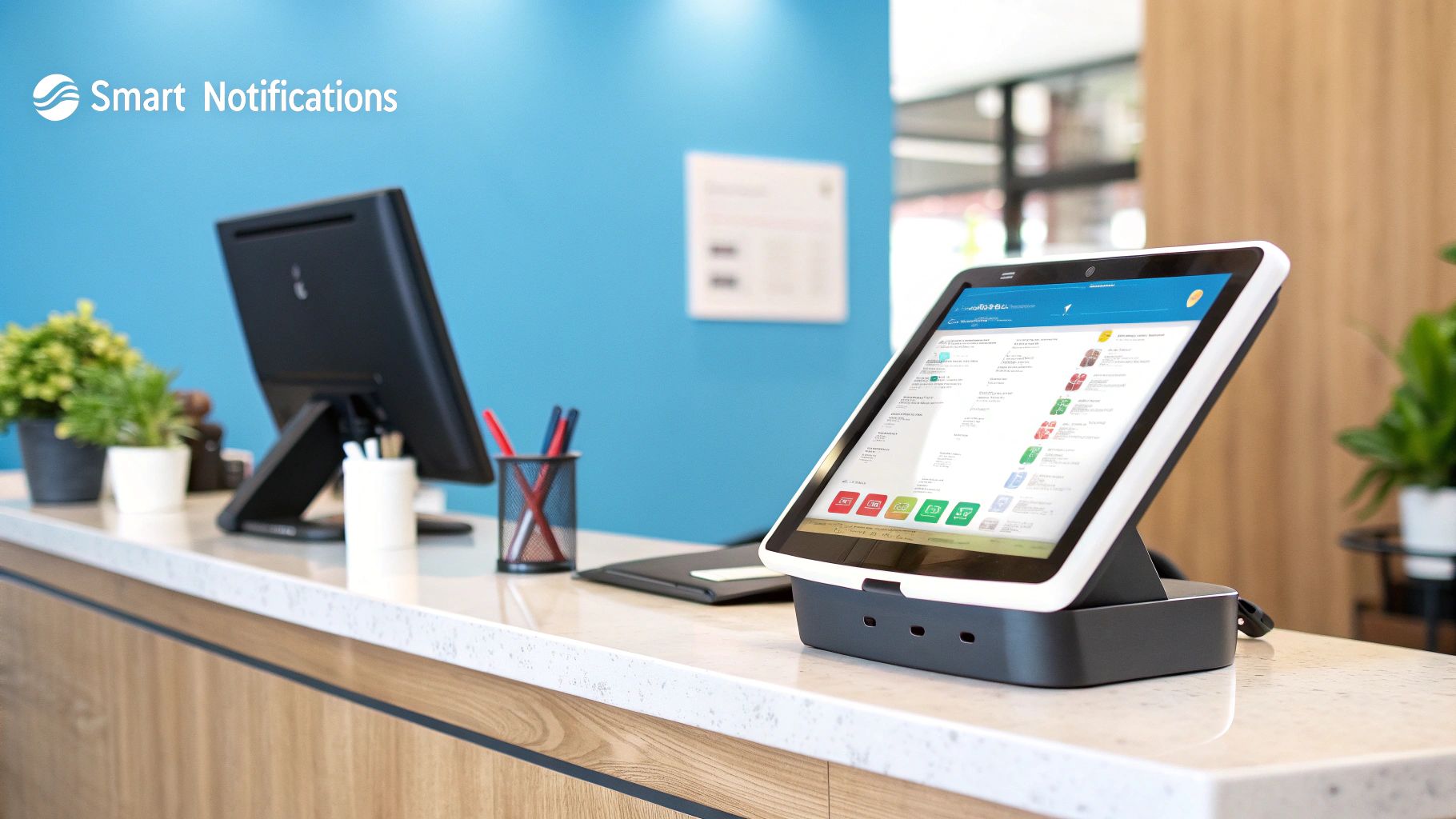
This digital-first approach aligns with modern privacy laws. A VMS ensures you collect data for a specific purpose, store it securely, and retain it only as long as necessary, helping you avoid significant legal risks and potential fines.
Mastering Compliance with Automated Controls
Manual compliance management is tedious and prone to human error. A VMS automates the entire process, providing peace of mind and auditable proof of your adherence to regulations. It's like having a 24/7 automated compliance officer.
The system ensures you obtain consent before collecting personal information and allows you to set custom data retention policies. For example, you can configure the system to automatically purge all visitor data after 30 days to comply with your company's policies, eliminating manual work. It's no surprise that corporate offices are the largest adopters, holding a 38.1% market share, driven by the need for enhanced security and compliance.
A visitor management system doesn't just record who came and went; it creates an unchangeable, time-stamped digital ledger. This provides the concrete, auditable proof required to satisfy regulators during an inspection, turning a stressful event into a routine check.
Building a Secure Data Ecosystem
The benefits extend beyond legal compliance. A VMS strengthens your entire security posture by managing information flow as rigorously as it manages people flow. Understanding how innovation meets security challenges is key for any modern business, and a VMS is a prime example.
Here’s how you benefit:
- Encrypted Data Storage: All visitor information is encrypted, protecting sensitive data from external threats and internal snooping.
- Detailed Audit Logs: In the event of a security incident, you gain instant access to a detailed log of who was on-site, when they arrived, who they met, and when they left. This is a game-changer for investigations.
- Secure Document Handling: You benefit from a streamlined and secure process for signing NDAs. Visitors sign on the check-in device, and the document is stored securely with their digital record, eliminating paper clutter.
By implementing these controls, a VMS actively reduces your organization's risk profile and fosters a security-first culture. To dive deeper, learn more about the 5 benefits of a visitor management system in our article.
Choosing the Right System for Your Office
Selecting the right visitor management system for your office is not a one-size-fits-all process. A bustling creative agency's needs differ vastly from those of a large corporate campus. The key is to look past features and focus on the strategic benefits your business will gain.
The goal is to find a system that solves your immediate front-desk challenges while supporting your long-term business objectives. It must enhance security, streamline operations, and be scalable. A poor choice leads to frustrated staff and a wasted investment. After all, a recent survey showed 86% of buyers will pay more for a great customer experience, which begins the moment a visitor enters your office.

Assess Your Office Environment
Before evaluating vendors, gain clarity on your specific needs. This self-assessment will guide you to a solution that truly fits.
Start with fundamental questions. How many visitors do you receive daily? A high-traffic lobby benefits from a system built for speed, with QR code check-ins to prevent queues. An office with fewer visitors might prioritize a highly personalized, branded welcome experience.
What are your primary security concerns? To protect intellectual property, you'll benefit from a system with seamless digital NDA signing. For buildings with strict access control, integration with door systems is essential to ensure visitors can only access authorized areas. This is vital not just for corporate headquarters but also for environments like healthcare facilities, where patient safety and compliance are paramount.
Focus on Core Benefits Not Just Features
Once you understand your needs, you can begin exploring options. It's easy to get lost in technical specifications. Instead, frame your evaluation around the three core benefits a quality visitor management system should deliver.
- A Seamless Guest Experience: How intuitive is the check-in for a first-time visitor? A confusing process creates a negative first impression. You'll benefit from a clean interface, pre-registration capabilities, and clear instructions that positively reflect your brand.
- Effortless Integration: A great VMS should integrate with the tools your team already uses. You gain massive efficiency when it can notify hosts on Slack or Microsoft Teams and sync with calendar apps to automate pre-registration.
- Scalability and Growth: Your business will evolve, and your VMS must be able to grow with you. You benefit from a system that can easily expand to new locations or handle increased visitor traffic, ensuring it remains a valuable asset for years to come.
For a deeper dive, check out our guide on https://visit-us.com/how-to-choose-the-right-visitor-management-system-for-your-business/.
Evaluating Key VMS Capabilities
To structure your decision-making, use a checklist to compare how different systems deliver on these core benefits. This keeps you focused on the value each capability brings to your office.
The best visitor management system is one that your guests find simple, your staff finds helpful, and your security team trusts completely. It should blend into your daily workflow so perfectly that you'll soon wonder how you ever managed without it.
This table outlines crucial capabilities and the real-world benefits they provide, helping you prioritize.
Evaluating Key VMS Capabilities
| Capability | Core Business Benefit | Priority Level |
|---|---|---|
| Pre-Registration & QR Codes | Cuts down lobby wait times and creates a professional, prepared welcome. | |
| Instant Host Notifications | Improves staff productivity and ensures no guest is left waiting around. | |
| Customizable Check-In | Reinforces your brand identity and captures only the necessary visitor info. | |
| Digital Document Signing | Streamlines compliance by getting NDAs and waivers signed electronically. | |
| Access Control Integration | Hardens physical security by automating visitor access permissions. | |
| Centralized Multi-Location Mgmt. | Ensures consistent security and branding across all your offices. | |
| Detailed Reporting & Analytics | Gives you valuable insights into lobby traffic for better resource planning. |
Use this guide to cut through the marketing noise. By rating each feature's priority based on your specific needs, you'll be well-equipped to find the perfect solution.
The Future of Visitor Management
The traditional front desk is evolving. The future of visitor management is not just about logging names; it's about creating a smarter, safer, and more connected workplace from the moment a guest arrives. The next generation of VMS is moving beyond simple check-ins toward predictive insights and fully automated experiences.
This transformation is powered by new technologies that deliver measurable business benefits. Instead of merely reacting to arrivals, these forward-thinking systems anticipate needs, optimize resource allocation, and create a seamless journey that showcases a modern, tech-savvy brand.
Harnessing AI for Smarter Operations
Artificial intelligence is becoming the operational brain of the modern front desk. By analyzing historical visitor data, an AI-powered visitor management system for offices can predict peak traffic times with remarkable accuracy. This allows you to benefit from proactive resource management, such as scheduling additional reception staff before a rush begins.
This foresight improves efficiency and guest satisfaction. A recent survey revealed that 86% of buyers will pay more for a superior customer experience, which starts in the lobby. AI ensures your reception area is never understaffed or chaotic, preventing frustrating bottlenecks.
The next generation of visitor management isn't just a system of record; it's a system of intelligence. It learns from your office's unique patterns to help you make smarter, data-driven decisions about staffing, security, and resource allocation.
By leveraging these insights, you can cultivate an environment that is both highly efficient and genuinely welcoming.
The Rise of the Touchless Visitor Journey
In response to heightened health and safety priorities, the shift toward touchless check-ins has accelerated. These solutions offer benefits far beyond hygiene. By empowering visitors with mobile-first options, they are revolutionizing the guest experience.
Advanced systems now integrate AI, mobile apps, and workplace analytics to enhance security and efficiency. Visitors benefit from the ability to pre-register, receive QR code badges on their smartphones, and check in without touching a shared device. This dramatically reduces wait times and eliminates paper waste.
This frictionless approach offers several key advantages:
- Enhanced Safety: It minimizes contact with shared surfaces, creating a healthier environment for everyone.
- Unmatched Convenience: Visitors can complete the check-in process on their own device before arrival, saving valuable time.
- Reduced Administrative Load: A fully automated mobile check-in frees up front-desk staff to focus on more complex, human-centric tasks.
Creating a Fully Integrated Ecosystem
The most significant leap forward is the development of a connected workplace ecosystem. A standalone VMS is an information silo. The future is an integrated environment where your visitor system communicates seamlessly with other building technologies.
Imagine this: a visitor checks in on their phone. Instantly, the system reserves a parking space, grants temporary Wi-Fi access, and unlocks their designated meeting room—all without human intervention. This integration transforms disparate steps into a single, intelligent workflow. This creates a fully automated journey from curb to conference room, eliminating manual tasks and potential errors. To stay ahead, explore the future of visitor management trends to watch in 2025 and see how these integrations are setting the new standard.
Common Questions About Visitor Management Systems
Upgrading from a paper logbook to a modern visitor management system is a significant step. It's natural to have questions about the real-world benefits and practicalities.
This section addresses the most common inquiries with clear, benefit-focused answers, covering security, usability, and integration. Our goal is to demonstrate how a modern VMS solves tangible problems, making your office safer and more efficient.
How Does a VMS Improve Security Over a Paper Logbook?
The difference is profound: a VMS provides active defense, not just a passive record. A paper logbook is merely a historical—and often inaccurate—document that cannot prevent an unauthorized person from entering. A visitor management system for offices, in contrast, acts as a digital gatekeeper.
You gain a real-time, accurate overview of everyone in your building. Unlike a scribbled paper entry, a VMS captures verified information, often with a photo, creating an unassailable record. Crucially, you benefit from the ability to screen visitors against watchlists and flag potential threats before they enter, with instant alerts sent to your security team.
An estimated 40% of workplace incidents are committed by external individuals. A VMS acts as the first line of defense, making sure only authorized guests get in and cutting that risk way down.
In an emergency, a VMS is invaluable. It can instantly generate an accurate evacuation list accessible from any mobile device, providing first responders with the critical information needed to account for everyone's safety. When integrated with access control, it adds another layer of security by restricting visitor movement to authorized areas.
Are These Systems Difficult for Non-Technical Staff to Use?
This is a valid concern, but modern systems are designed for simplicity and ease of use. The core benefit is making work easier, not more complex.
For visitors, the self-service check-in is intuitive. A recent study found that 88% of users prefer self-service options for their speed and privacy. The guided process on a tablet is straightforward and typically takes less than a minute, creating a smooth, professional welcome.
For your administrative staff, the back-end dashboard is equally user-friendly. It is typically a clean, web-based interface requiring minimal training. They can pre-register guests, manage visitor lists, and generate reports with a few clicks. Furthermore, a reputable provider will offer comprehensive onboarding and ongoing support to ensure your team feels confident from day one.
Can a VMS Connect with the Other Software We Use?
Absolutely. This integration capability is where a VMS delivers its greatest value. A modern visitor management system is designed to connect with the tools your business uses daily, creating automated workflows that save significant time.
These integrations transform multiple manual tasks into a single, seamless process. Consider the efficiency gains:
- Communication Tools: Benefit from instant host notifications on Slack or Microsoft Teams the moment a guest arrives, eliminating phone calls from reception.
- Calendar Applications: Gain efficiency through synchronization with Google or Outlook calendars. Inviting a guest to a meeting automatically pre-registers them and sends a confirmation email with a QR code for a rapid check-in.
- Access Control Systems: Enhance security by linking with your door hardware to grant visitors temporary, restricted access that automatically revokes upon check-out.
These connections elevate a VMS from a simple sign-in app to a strategic business tool that streamlines information flow and simplifies work for everyone.
How Does a VMS Work for a Company with Multiple Offices?
Managing a consistent visitor experience and security protocol across multiple locations is a significant challenge. Cloud-based visitor management systems are designed to solve this problem by providing a single, centralized management hub.
From one web-based dashboard, your operations or security manager gains a complete, real-time overview of visitor activity across all sites. You can analyze data, review logs, and configure settings for any office, from anywhere in the world. This centralized control allows you to enforce company-wide policies with ease, such as requiring all visitors to sign a universal NDA. At the same time, you retain the flexibility to customize the check-in experience for each location with unique branding or instructions. It's the ideal blend of global oversight and local customization, perfect for growing businesses.
Ready to enhance your office security and create a seamless visitor experience? VisitUs offers a powerful, intuitive, and secure visitor management system designed for modern workplaces. From touchless check-in and real-time notifications to robust compliance features, our platform provides everything you need to protect your people and your property. Discover how VisitUs can transform your front desk by exploring our solutions.
